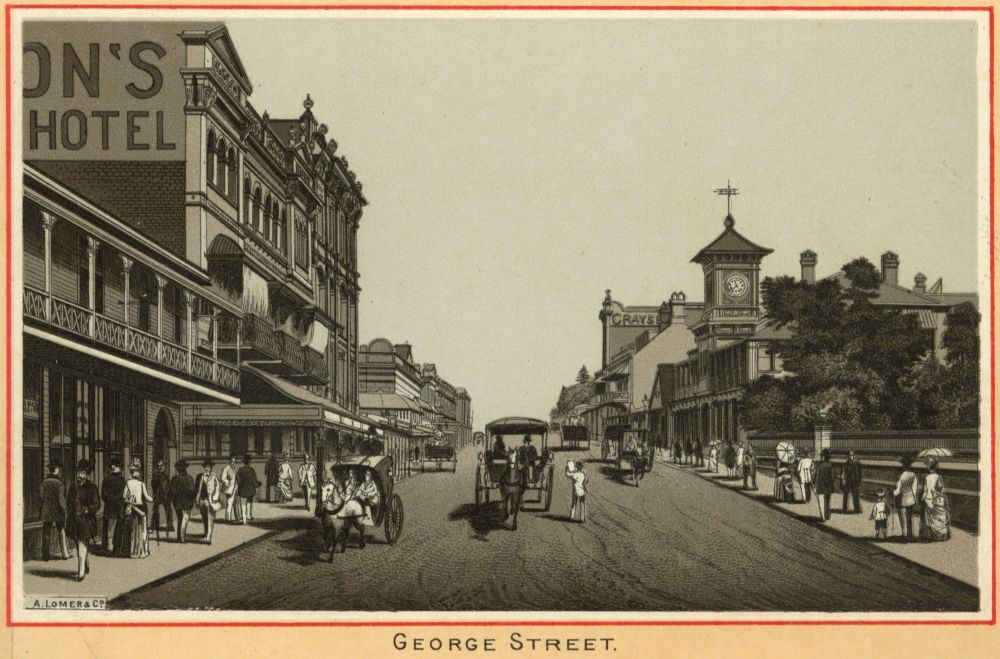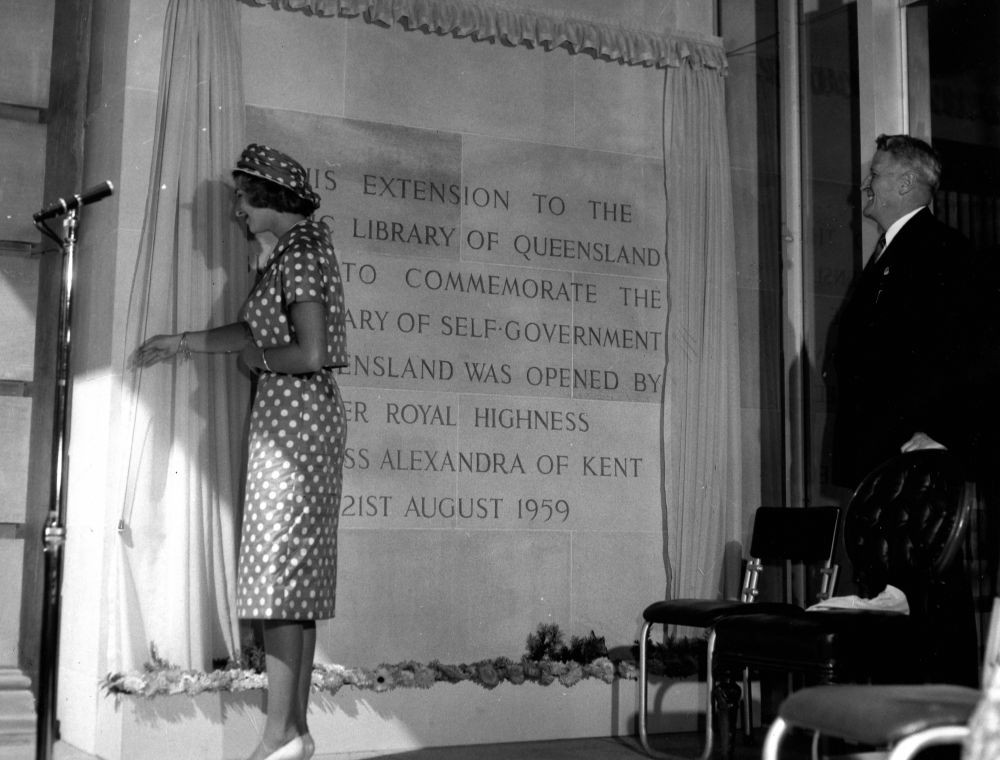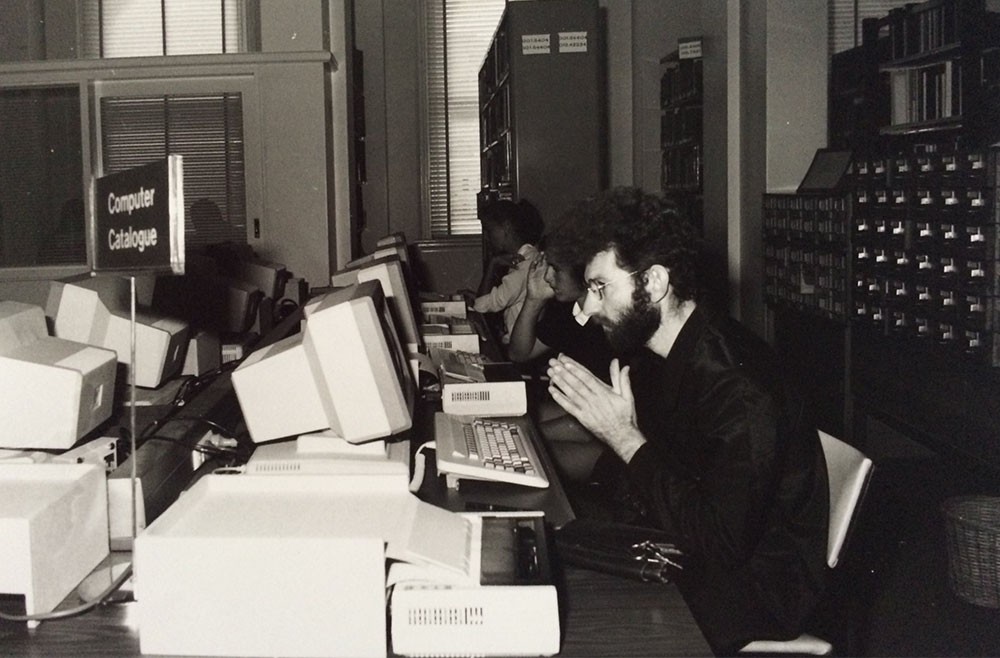Dear Reader,
Not all stories have fairy-tale endings, or beginnings for that matter.
But they do involve obstacles to overcome and moments of gratifying triumph.
State Library of Queensland’s story is one such adventure. And like fairy tales from long ago, ballgowns and princesses can most certainly be found within our walls. Although, dear friend, locating a glass slipper might require detective work through our catalogue.
This year we celebrate 120 years of service to the great state of Queensland. Our story is your story, so grab a parasol or bowler hat, we are heading back to colonial times.

Carriages but no books
Now, if you were an aspiring prince or princess in the mid-1800s, bustling thoroughfares like Edward Street in Brisbane were ideal places to promenade. Carriage makers and purveyors of taffeta, fine silk and parchment could all be found along its streets. Watch out for the dust and those seasonal puddles! But what you would not find amongst all this trade and commerce was a public library. No refuge from the heat and hustle just yet I am afraid. Beautifully bound books resided in private collections and public education fell out of favour after primary school. Now come along ...
When Queensland was declared a colony in 1859, enthusiasm for a public library remained rather muted; it was considered a luxury in a landscape beset by debt, droughts and floods. When the library was finally established, a mere 18 per cent of the colony’s population could be found in metropolitan areas (compared with 40 per cent in NSW and 53 per cent in Victoria). While there remained a more pressing need for railways and port expansions, book lovers remained undeterred.
Momentum was building, thanks to public demand. Subscription services at the Mechanics' Institutes and the School of Arts flourished throughout the state, revealed a public appetite for fiction. The upper classes were none too pleased; scandalous tomes such as Wuthering Heights, Treasure Island and Middlemarch were undoubtedly greedily consumed by avid subscribers.

Cash and candle wax
In 1896, the mayor of Brisbane, a bearded chap by the name of Robert Woods Thurlow, called a public meeting to discuss the establishment of a free public library. It was a fairly lonesome affair, with only a few folk turning up. But it was not an entire waste of candle wax. The government agreed to the notion and allocated an annual grant of £500 for a public reference library. Now we are getting somewhere dear reader.
The money was promptly spent on over 4,000 books, part of the extensive private library of Justice George Rogers Harding. A great reader who was also rather fond of a good banquet (mock turtle soup anyone?). There were even unconfirmed reports the good judge entertained royalty, but that mystery is for another time.
Now that the government's money was spent, there was one trifling problem; there was nowhere to put these beautiful books.

Larrikinism and petty disturbances
For the first year, the collection of books (known as Brisbane Public Library) was stored in the Colonial Secretary’s Office in William Street. It was then moved into George Street, with an additional 6,000 volumes added to the collection through donations. We love our kind donors!
In 1889, it was renamed the Public Library of Queensland and the Dewey classification system was used to catalogue the collection. While we were the last colony to establish a free public library service, we were the first to adopt the Dewey system so let us pause to afford our librarians a small smile of satisfaction.

Sydney’s Principal Librarian was rather sniffy about Queensland’s hoi polloi, advising against full public access to the collection. Unsurprisingly Queenslanders took a contrary view, boldly declaring the social advantages of such a move outweighed any “trifling” losses or damage that might occur to public property.
At the first Board of Trustees meeting in 1896 it was boldly hoped that a public library would help prevent “the spread of larrikinism” on the streets of Brisbane.
The trustees felt that men should be able to access books away from the “little disturbances of home” so they could “study the great works of history, poetry, and science”.
We’ll let that pass dear reader, it was over a hundred years ago after all.
The NSW Librarian reminded Queensland books for lending should be of a “good sort, not trashy cheap novels”. Hopefully the recently published My Brilliant Career escaped his disapproving gaze.
Miss Maude and a scandalous start
In 1902 the collection was moved into the old Museum building in William Street after it was renovated, and the basement strengthened to “carry the weight of 100,000 volumes”.

And jubilation dear reader, on the 29th of April that same year, the library was finally opened to the public. Books on philology, theology, sociology, and the natural sciences were purchased with enthusiasm, but services were understandably limited.
An offer from the Brisbane Electric Supply Company to install electric lights in the building was declined as it was deemed too costly. The library had to close early in the winter due to the fading light.
We got off to a bit of a shaky start with the first Acting Public Librarian. After a short time in this esteemed role, Evan Roland Jones, a Sydneysider no less, was dismissed for misappropriating funds.
Miss Maude Jackson was brought in to clear up the mess but found her salary was slashed from £175 to £60 (just a smidge more than the message boy) because she was a woman. Duly unimpressed by this surcharge on her sex, she quickly resigned. We applaud Maude’s principled stance and hope she was not forced back into the petty “disturbances of home”.
Fifteen years later, on 1 July 1917, Mr W H Brown was appointed Public Librarian, and the premises was duly staffed with blokes, some with questionable moustaches.
Nearly 30 years on, with plenty of experience tucked under his belt he neatly summarised his approach to customer service: "We get all sorts here – and people are all right if you treat them alright." Quite right Mr W H Brown.

In 1934 The Oxley Memorial Library officially opened as a centre for research and study relating to Queensland. The modern-day (renamed) John Oxley Library has plenty of tantalising treats like diaries, artworks and original manuscripts.
Insert dramatic music
In need of a sherry yet? Hang in there dear reader, the excitement doesn’t stop yet.
Enter Ralph Munn, Director, Carnegie Library of Pittsburgh. In 1934 he and the Chief Librarian of Public Library of Victoria embarked on a survey of Australian public libraries.
Their findings were grim and even a little unkind one might say. They remarked:
Most Australians have had no contact with a progressive and complete library system and know nothing of its functions or facilities. It is pathetic to observe the pride and complacency with which local committees exhibit wretched little institutes which have long since become cemeteries of old and forgotten books.
Ouch!
And I can assure you our humble library did not escape punishment.
"Anyone wishing to carry away a favourable impression of the Public Library of Queensland should never make the mistake of entering it. Its exterior is dignified and pleasing but when the building is once entered almost everything appears wrong."
"The interior of the library is a barn-like room, poorly lighted, badly in need of painting, and shabby and uninviting in every feature."

“No member of the present staff has had a university education. The staff consists of seven including the book-binder and the errand boy.”
“Its reorganisation should be undertaken without delay, and a reasonable proportion of the nourishment which has been withheld by the state from its starved body should be made available at once. Only by these means will it be able to recover from its present state of inanition and decay.”
Undaunted, we dusted off our dust jackets and set out in search of nourishment … and action. The Libraries Act was passed in 1943 and four years later the position of State Librarian was created. In 1947 the Country Extension Service allowed the distribution of books to regional and country folk and in 1954 services we started expanding our service to include Indigenous communities such as Cherbourg and Palm Island.
A princess in a spotty dress … and some computers
And finally, we find a princess on our very doorstep. Following the renovation of our “barn-like” building in 1959, Princess Alexandra visited our roomy new reading rooms for some ribbon cutting (alas no sign of a glass slipper, but a lovely spotted dress).

In the 1970s, well before Microsoft mogul Bill Gates suggested a computer would someday be in every home, we were busy developing a computer-based library catalogue for our cherished readers.
In 1988 we put our sombre appearance behind us, setting up new digs in the Cultural Centre at South Bank at the same time we were all buying seasons passes to World Expo 88.
With the dawn of a new century, we embarked on our most ambitious project yet; the Millennium Arts Project which included a major redevelopment of the State Library building. Well, that and the appointment of the very first female State Librarian. Take a bow Lea Giles-Peters, it only took 99 years.
On 25 November 2006, the redeveloped building opened to the public (larrikins included). Twice its former size, the new State Library is in the heart of the Queensland Cultural Centre at South Bank.
If Carnegie Library’s Ralph Munn was still alive, he would now need to hold on to his hat.
One year after opening our magnificent new building, designed by Donovan Hill Peddle Thorp, we received Australia’s top prize for public architecture: the Royal Australian Institute of Architects' Sir Zelman Cowen Award for Public Architecture, 2007. It sets a benchmark for state libraries in the southern hemisphere. Barns, begone!

We are nearing the end of our travels dear reader. We have certainly come a long way in 120 years.
Not only can we afford our electricity (and wi-fi) bills, but our vision and services are unrecognisable from those early moustachioed days.
Today we are a cultural institution of global influence. A place of experimentation, possibility, and inclusion, where knowledge empowers, and diversity is celebrated.
And storytelling is, of course, embedded in our DNA.
And what of princesses and ballgowns you may well ask? Well, the truth is we aren’t that obsessed with them. But we love a good story, and we love sharing Queensland’s history.
As the custodian of Queensland’s memory, we want everyone’s story represented. Why not share yours?
Now, time for some cake!

Comments
Your email address will not be published.
We welcome relevant, respectful comments.